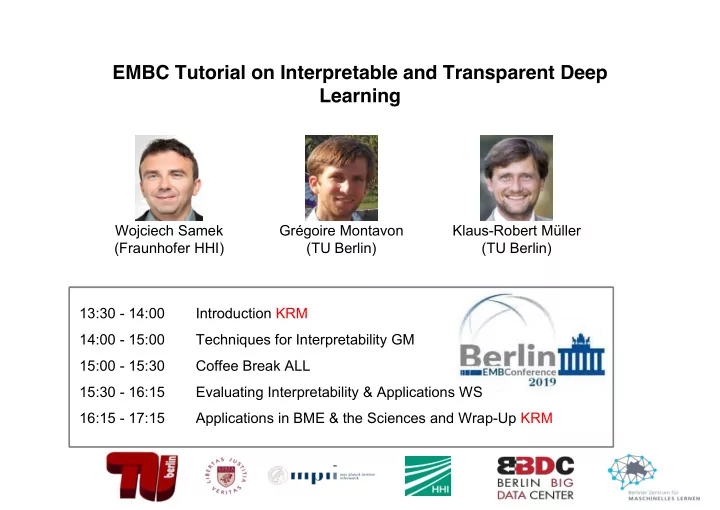

EMBC Tutorial on Interpretable and Transparent Deep Learning Wojciech Samek Grégoire Montavon Klaus-Robert Müller (Fraunhofer HHI) (TU Berlin) (TU Berlin) 13:30 - 14:00 Introduction KRM 14:00 - 15:00 Techniques for Interpretability GM 15:00 - 15:30 Coffee Break ALL 15:30 - 16:15 Evaluating Interpretability & Applications WS 16:15 - 17:15 Applications in BME & the Sciences and Wrap-Up KRM
Why interpretability?
Why interpretability?
Why interpretability?
Why interpretability?
Why interpretability? Insights!
Why interpretability?
Overview and Intuition for different Techniques: sensitivity, deconvolution, LRP and friends.
Understanding Deep Nets: Two Views Understanding what mechanism Understanding how the network the network uses to solve a relates the input to the output problem or implement a function. variables.
Approach 1: Class Prototypes “How does a goose typically look like according to the neural network?” non-goose goose Class prototypes Image from Symonian’13
Approach 2: Individual Explanations “Why is a given image classified as a sheep?” non-sheep sheep Images from Lapuschkin’16
3. Sensitivity analysis input evidence for “car” DNN Sensitivity analysis: The relevance of input feature i is given by the squared partial derivative:
Understanding Sensitivity Analysis Sensitivity analysis: Problem: sensitivity analysis does not highlight cars Observation: Sensitivity analysis explains a variation of the function, not the function value itself.
Sensitivity Analysis Problem: Shattered Gradients [Montufar’14, Balduzzi’17] Input gradient (on which sensitivity analysis is based), becomes increasingly highly varying and unreliable with neural network depth.
Shattered Gradients II [Montufar’14, Balduzzi’17] Input gradient (on which sensitivity analysis is based), becomes increasingly highly varying and unreliable with neural network depth. Example in [0,1]:
LPR is not sensitive to gradient shattering
Explaining Neural Network Predictions Layer-wise relevance Propagation (LRP, Bach et al 15 ) first method to explain nonlinear classifiers - based on generic theory (related to Taylor decomposition – deep taylor decomposition M et al 16 ) - applicable to any NN with monotonous activation, BoW models, Fisher Vectors, SVMs etc. Explanation : “ Which pixels contribute how much to the classification ” ( Bach et al 2015 ) (what makes this image to be classified as a car) Sensitivity / Saliency : “ Which pixels lead to increase/decrease of prediction score when changed ” (what makes this image to be classified more/less as a car) (Baehrens et al 10, Simonyan et al 14 ) Cf. Deconvolution : “Matching input pattern for the classified object in the image ” ( Zeiler & Fergus 2014 ) (relation to f(x) not specified) Each method solves a different problem!!!
Explaining Neural Network Predictions Classification large activation cat ladybug dog
Explaining Neural Network Predictions Explanation cat ladybug dog Initialization =
Explaining Neural Network Predictions Explanation ? cat ladybug dog Theoretical interpretation Deep Taylor Decomposition depends on the activations and the weights: LRP naive z-rule
Explaining Neural Network Predictions Explanation large relevance cat ladybug dog Relevance Conservation Property
Historical remarks on Explaining Predictors Gradients Sensitivity Gradient vs. Decomposition (Baehrens et al. 2010) (Montavon et al., 2018) Sensitivity Sensitivity (Morch et al., 1995) (Simonyan et al. 2014) Gradient times input DeepLIFT Grad-CAM Integrated Gradient (Shrikumar et al., 2016) (Shrikumar et al., 2016) (Selvaraju et al., 2016) (Sundararajan et al., 2017) Decomposition LRP for LSTM LRP (Arras et al., 2017) Probabilistic Diff (Bach et al., 2015) (Zintgraf et al., 2016) Excitation Backprop (Zhang et al., 2016) Deep Taylor Decomposition (Montavon et al., 2017 (arXiv 2015)) Optimization Meaningful Perturbations LIME PatternLRP (Fong & Vedaldi 2017) (Ribeiro et al., 2016) (Kindermans et al., 2017) Deconvolution Deconvolution Guided Backprop (Zeiler & Fergus 2014) (Springenberg et al. 2015) Understanding the Model TCAV Deep Visualization (Kim et al. 2018) Synthesis of preferred inputs (Yosinski et al., 2015) Inverting CNNs (Nguyen et al. 2016) Feature visualization (Dosovitskiy & Brox, 2015) (Erhan et al. 2009) Network Dissection Inverting CNNs RNN cell state analysis (Zhou et al. 2017) (Mahendran & Vedaldi, 2015) (Karpathy et al., 2015)
Recommend
More recommend